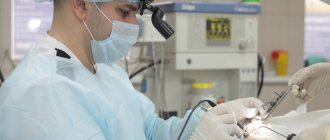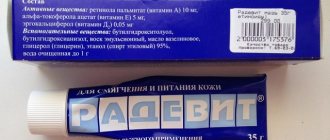Septoplasty
This surgical operation corrects a deformed nasal septum and removes growths from the cartilaginous and bony septum. Often this operation is combined with rhinoplasty, which makes it possible to correct the shape of the nose in parallel with solving the problem of difficulty breathing.
Indications and contraindications for septoplasty
Congenital or acquired pathologies cause deformation changes in the nasal septum. Most often these are mechanical injuries to the nose, polyps and tumors, and tissue development disorders. Curvatures and displacements of the septum manifest themselves in the form of deformation of cartilage tissue or the formation of a ridge, a bone spike, or a combination of these. This, in turn, leads to the development of inflammatory processes in the nasal sinuses, loss of smell, discomfort when breathing, and due to insufficient oxygen supply, memory loss and decreased performance.
Indications for septoplasty are:
- disruption of the nasal breathing process;
- chronic runny nose;
- frequently recurring nosebleeds;
- snoring during sleep;
- asymmetrical nose shape.
The presence of diabetes, oncology, acute infections, exacerbation of chronic ailments, low blood clotting are factors in which septoplasty is contraindicated.
Methods of performing the operation
Correction of defects occurs in several ways.
- The classic or open method of nasal septum correction is used to eliminate severe deficiencies. If it is used, incisions are made in the columella area using a scalpel to gain access to the tissue. Depending on the individual characteristics of the patient, the surgeon performs excision and alignment of the cartilage and puts it in place. Currently, this method of operation is used in exceptional cases, since it is traumatic.
- The laser method involves the use of specialized equipment. During the operation, which usually lasts about half an hour, a laser beam cuts tissue and corrects the nasal cavity while maintaining the natural integrity of the nasal septum. The advantages of such a procedure include:
- the ability to avoid postoperative hospital treatment;
- reducing the risk of tissue infection;
- prevention of nosebleeds during the recovery period.
- The endoscopic method of surgical intervention involves inserting an endoscope with a camera into the nasal passages, transmitting an image to a monitor, and performing resection of the nasal septum. The duration of the operation depends on the complexity of the specific situation and is 50-120 minutes.
Less popular methods of correcting defects in the nasal cavity include the radiosurgical method, which uses a radioknife, as well as the ultrasound method, which involves the use of ultrasound equipment.
Types of septoplasty of the nasal septum
Conservative methods are powerless in combating the problem.
The curvature can only be corrected surgically. The operation is performed using several methods. Types of septoplasty of the nasal septum:
- classical;
- endoscopic;
- laser;
- ultrasonic;
- radio wave.
Classic method
Classic septoplasty is performed using a surgical scalpel. The specialist treats the mucous membrane with antiseptic agents and separates it from the cartilage tissue. Then an incision is made on the latter and the deformed part of the cartilage or bone is separated.
In case of severe curvature, the septum is temporarily removed, straightened and put back. If minor, correction is carried out in the nasal cavity. Suture material is applied to the incision areas. Tamponades or special silicone plates are installed in the nasal passages. Sometimes, to prevent the cartilage from moving, a special self-absorbing mesh is additionally applied.
The operation has been known for a long time, but they try to perform it rarely and only with serious curvatures, because:
- it is traumatic;
- it is difficult to record seized elements;
- there is a high risk of back sagging or tip drooping;
- long recovery.
Endoscopic septoplasty is performed using an endoscope. It is inserted into the nasal passage. Using special instruments, the surgeon corrects the curvatures and removes the deformed parts. At the same time, the specialist constantly monitors the progress of the procedure on the monitor. The operation preserves the integrity of the bone elements.
Laser septoplasty of the nasal septum is a rather ambiguous term. The procedure can be carried out using two methods:
- Classic correction, but using a laser rather than a surgical scalpel.
- Laser septochondrocorrection is an innovative technique in which cartilage is heated to a certain temperature, after which it becomes plastic. This allows the surgeon to simulate its position. When the fabrics cool, the new shape is retained.
Ultrasound septoplasty effectively eliminates septal defects such as spines and ridges. It is performed using high-energy ultrasound, which dissects cartilage tissue and coagulates blood vessels. The operation does not involve any incisions or stitches. The rehabilitation period is short.
Radio wave septoplasty of the nasal septum is considered the most gentle method of surgery. The procedure is carried out using special equipment that produces a high-frequency radio wave beam. During surgery, it instantly coagulates the vessels, so there is no blood loss. In addition, it disinfects the surface, which reduces the likelihood of infection to zero. The technique is effective only for cartilage deformities.
The price of laser septoplasty of the nasal septum largely depends on the method of its implementation, the degree of curvature, the specific clinic, and the city. For example, laser septochondrocorrection will cost 4-6 times more than excision of defects with a laser scalpel. Because the technique is new, the equipment is very expensive, which may not be profitable for the patient. Correction with a laser scalpel costs from 35,000 rubles.
Vasotomy
A surgical operation during which the volume of blood vessels is reduced. Depending on the extent of the damage, surgery may be performed on one or both turbinates.
Indications and contraindications for vasotomy
The indication for the surgical procedure of vasotomy is impaired nasal breathing function due to an enlarged turbinate. This is a pathology in which the nasal mucosa is greatly thickened and swells at the slightest irritation. Difficulty breathing in this case is the result of vasomotor, medicinal or chronic rhinitis, which is not amenable to conservative treatment, as well as the presence of endocrine diseases that cause hypertrophy of the nasal cavities. Simply put, the mucous membrane swells, the nasal passages narrow, and the passage of air becomes difficult.
Contraindications to their implementation are acute infections, including purulent processes in the ENT organs, exacerbation of chronic diseases.
Methods of performing the operation
Currently, reducing the volume of the nasal concha is carried out in several ways. The choice of method is made by an otolaryngologist, based on the nature of the disease, age and individual characteristics of the patient.
- Instrumental is a classic method of eliminating hypertrophy, which involves exfoliation of the mucosa and elimination of vascular bundles. Damaged vessels do not recover over time, which serves as a reliable prevention of relapses. The duration of the procedure is about 15 minutes.
- Turbinoplasty is the most effective method used to solve complex cases. It involves removing part of the turbinate through a small incision, while preserving the mucous membrane. The disadvantage of turbinoplasty is that it is traumatic and prone to complications.
- The laser method is an effective and low-traumatic method in which a light guide is inserted into the nasal cavity, the beam of which evaporates tissue.
- Radio wave disintegration is a modern effective method of eliminating tumors, which involves introducing a radio wave-producing probe under the mucous membrane. As a result of vibrations of radio waves, coagulation of blood vessels occurs, leading to normalization of the size of the nasal passages.
- Cryodestruction is a procedure in which the mucous membrane is treated with a cryoprobe, which destroys cell membranes using low temperatures. This causes thrombosis of capillary vessels, their bleeding and elimination of swelling.
- Coblation is a method of radio wave surgery that involves exposing tissue to a field of cold plasma. As a result of this effect, molecular bonds are broken, blood vessels are destroyed, and the nasal turbinates acquire a normal size.
Minimally invasive operations are an alternative and more modern method of performing vasotomy
Among other modern low-traumatic methods of performing vasotomy, the following are recognized as highly effective: ultrasonic disintegration (USD), vacuum resection.
How is rehabilitation going?
With vasotomy, the patient can leave the clinic 2 hours after the operation. The operation is bloodless, packing is not required after the intervention.
Recovery after septoplasty lasts about 3 months and is divided into 2 periods.
During the first, postoperative, the patient is placed with cotton-gauze turundas or silicone splints in the nasal passages, which allows the normal position of the nasal septum to be fixed and bleeding to be prevented. During this period, it is recommended to observe a relaxed bed rest. Due to natural swelling and tampons in the nose, nasal breathing is impossible during this period, and therefore the patient has to breathe through the mouth, which causes the development of:
- headaches or dizziness;
- drying of the oral mucosa and cracking of the lips;
- swelling of the nasopharynx;
- increased blood pressure.
Due to pain after vasotomy and septoplasty, in most cases the patient is prescribed painkillers
On the 3-4th day, the turundas are removed, and from this moment the second stage of recovery begins. In the first week, the nasal cavity should be moistened every 3 hours, using saline and special moisturizing sprays, apply ointments, remove blood clots and crusts. On the 10th day, if the patient’s work does not involve physical labor, he can go to work. The swelling of the nose that appears after surgery usually goes away within 3 weeks, during which time the ability for normal nasal breathing is completely restored. The function of smell that has not recovered within 2 months is considered a complication, the treatment of which will require several months. Other common complications are the development of inflammatory processes, bleeding, and septal perforation.
During the recovery period both after septoplasty and after vasotomy, it is important to observe personal hygiene and medical recommendations. Moreover, in the first 2 weeks after surgery it is prohibited:
- carrying out procedures related to visiting a bathhouse or solarium;
- physical activity, and primarily bending;
- wearing glasses;
- eating spicy, hot or carbonated foods;
- sleeping on your side or stomach.
During the first year after septoplasty, the use of vasoconstrictors is strictly prohibited. The only exceptions are cases of special medical appointment, provided there are no complications and 3 months have passed since the operation.
Treatment and restoration of nasal breathing after septoplasty
Restoring nasal breathing after septoplasty is, of course, the main reason that causes inconvenience for any adult, and even more so for a child. To quickly eliminate this problem - nasal congestion - it is necessary to follow the prescribed treatment after septoplasty.
After correcting a defect (deviated nasal septum) by surgically correcting the cartilage, the problem arises of the inability to breathe through the nose due to swelling. In addition, crusts accumulate in the nasal cavity. If they are not removed in time, they lead to diseases and consequences such as perforation of the nasal septum due to suppuration and even sinusitis.
To prevent this, doctors prescribe antiviral drugs and various moisturizers in the form of sprays and drops, which need to be used to irrigate the nasal passages every three hours for 2-3 weeks, until the swelling goes away, the nasal passages are completely free, and as a result, nasal breathing is no longer possible. will become free.
It should be remembered that the use of vasoconstrictor drops after septoplasty is strictly prohibited for a year! The exception is cases when the use of medication is the only way to breathe properly, there were no complications after the operation, more than three months have passed since the operation, and the doctor prescribes them to the patient.
Combined septoplasty and vasotomy
A complex operation - septoplasty with vasotomy - is performed in cases where a deviated nasal septum is accompanied by swelling of the nasal passages. During this procedure, the surgeon, using an ultrasonic scalpel, makes the cartilage plate smooth and also partially dissects the vessels of the mucous membrane, making them thinner and reducing their sensitivity.
A successful operation ensures normalization of the respiratory process. During its implementation, the surgeon has the opportunity to correct imperfections in the shape of the nose, making it aesthetic and attractive. A harmonious combination of beauty and health is the result of a high-quality operation.
Possible complications after septoplasty
Any surgical intervention carries health risks, and laser correction of the nasal septum is no exception.
Many people note that they cannot breathe through their nose after septoplasty. This manifestation is associated with tissue swelling. After 48-72 hours it goes away on its own. Headaches and dizziness also occur after anesthesia. After removing the tampons, it is difficult to breathe because the mucous membrane is injured and inflamed. Crusts form in the nose after septoplasty. They should be removed with care using cotton swabs dipped in oil.
More serious consequences are possible:
- unsatisfactory shape of the nose, septum;
- hematomas;
- bleeding;
- perforating damage to the septum.











